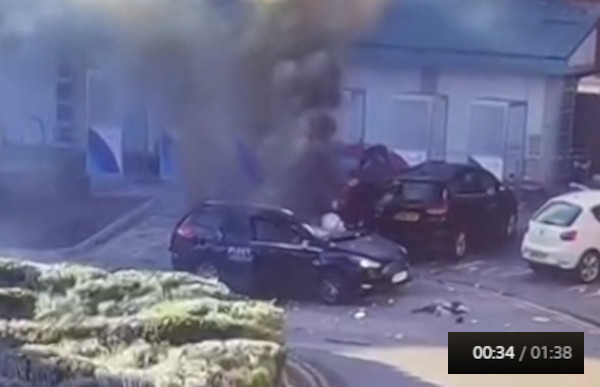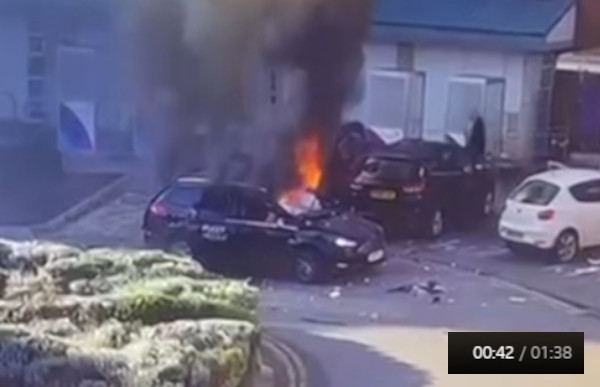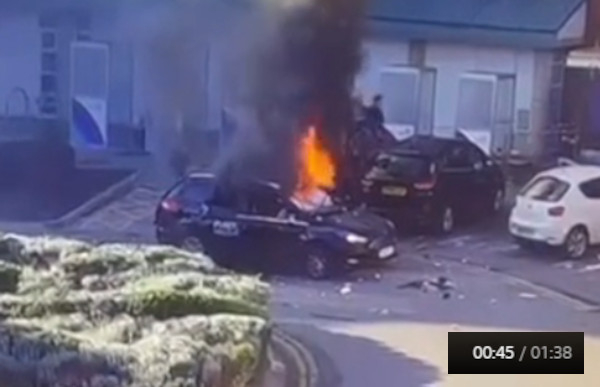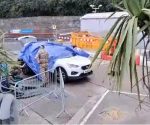The Liverpool Women’s Hospital Incident; Part Three: No bomb – and no bomber, even?
Although this article had been promised as being about how the features of the explosion, in last Sunday’s Liverpool Women’s Hospital “terror” incident, undermined what was being claimed about a “bomb” by corporate-media and through it the security services, there needs to be a segue to it through a piece inserted into the running order in this series; i.e., this article. With the release of certain witness account since the previous article, it has become necessary to look into the possibility that Emad Al Swealmeen was not in David Perry’s taxi when it was incinerated in a fire.
As outrageous as the statement just made might sound, very simple general evidence is available to us that, in combination with what we can see with our own eyes in video footage, and the result of assessing witness testimony with discernment, is very compelling in making a case for no passengers in the car.
The simple general evidence referred to is available in abundance on the internet: videos that show car alarms being set off by fireworks. The point being made is that the “bomb” at the Liverpool Women’s Hospital could not do what a can full of Catherine Wheels could at 20 yards. In the CCTV footage that shows the hospital incident, there are no indications that alarms were triggered in any of the four unattended parked cars that were arranged in a quarter-circle around the passenger side (these ones being only a matter of feet away) and the front of the minicab when it came to a halt. While the odd manner by which the footage was created might be a good excuse as to why the sound of even one alarm could not be heard (the film was recorded on a handheld device pointed at a monitor on which the footage was being shown [and don’t let controlled alternative media disinform you otherwise, reader]), it certainly doesn’t explain why none of the usual flashing of lights can be observed.
While a full discussion on the behaviour of the blast really is for another time, fitting the scenario of the “bomb” having no effect on what are essentially detectors placed horizontally adjacent to the source of the blast, the way that white smoke appeared instantaneously above the taxi, to continue to rise and dissipate, demonstrates little or no lateral force. Very helpfully indeed, showing that we can all see the same thing on the video, a FBEL reader commented on the feebleness of the explosion under the previous piece in the series. And in relation to that comment, while the author agrees it is more than likely that the car was actually destroyed by a device that started a fire – which is not the same as a bomb – it is quite possible that the appearance of white smoke was unrelated. In other words it was smokescreen to present the illusion of a bomb. And the greatest evidence for this is the unscathed driver who managed to walk away from the vehicle even though he was seated inside during the so-called explosion.
To bring the discussion to a point, the incident has hallmarks of being a special effects stunt. Following from that, if this event was merely a matter of a system rigged for the purpose of creating the effect of an explosion, a passenger in the car acting as a delivery agent would be an entirely redundant feature. Thus it is entirely reasonable to contemplate the possibility that the taxi driver David Perry was alone in the vehicle.
On the face of it, it might seem an outrageous thing to suggest that Emad Al Swealmeen was not at the scene of his alleged crime, especially in the light of the stories coming from corporate-media where David Perry evidently reported the apparent fact of a passenger to a hospital security man. However, it should be noted that so far all comment from David Perry has been conveyed to the public from third parties, and then through the producers of the corporate-media content. The intermediaries are mostly cited as being partially named “mates” giving Facebook bulletins, but one has been identified fully and, indeed, as the security man who first dealt with David Perry after he had affected his escape. When Darren Knowles was quoted directly in a 17th November Daily Mirror article, he appeared to be pretty clear about the question of another body in the car:
Darren said: “David was just so disorientated and confused.
“He was trying to tell us, ‘There is a passenger, there is a passenger’.
“I was trying to say to him, ‘Is he still in there’, and he was saying, ‘He has tried to blow me up, he has tried to blow me up’.”
However, all of this is very different to what is presented in the very first line of the same reportage:
The cabbie who survived the Liverpool bomb attack told rescuers: “Someone has blown me up.”
In this version, David Perry says something that is more likely to be said in a situation where the perpetrator of the act is unknown: it is “someone”, and not, for example, “my fare”, or “my passenger”. So, we must start to wonder, in the light of the existence of this apparently widely shared version of David Perry’s immediate account, why Darren Knowles is in unique possession of a specific version. Could it be because Darren Knowles is a person of interest, having appeared in the video of the incident, and so would be expected to speak to corporate-media?
Furthermore, at no point in the video is Knowles seen reacting as if he had learnt that there was another person in the car – after running from his starting position to catch up with David Perry, the two then exit centre stage towards what might be called the left wing. Knowles eventually returns to his own car, on the right wing, without passing close to the burning vehicle, where he attends to a tyre. It is hardly the behaviour of a man who knows that a human being is burning alive not twenty yards away.
Moreover, Knowles’ account is clearly telling the reader that no answer was given, positive or negative, to a question put to Perry regarding any passenger remaining in the car.
Now, none of this is to say that Darren Knowles would have been asked to enhance his story to make it tolerant of the official narrative. Any immediate assumption he might have made that Perry had a passenger, even if it didn’t appear to bear out during the course of the incident, would be confirmed on receipt of the official narrative. At that point, truthful memories can become viewed as being faulty in order to compensate for missing or incongruous data (that the official voice asserting a fact can override a contradicting memory has been demonstrated in laboratory experiments). In any case, look carefully again at the only line that indicates that Perry has made any sign that another person was in the car:
“He was trying to tell us, ‘There is a passenger, there is a passenger’.
Trying to tell us. We are left wondering, was the fact of a passenger articulated by Perry to Knowles, or was it constructed in compensation so that, in fact, Knowles should have said “If he could, he would have told us…”.
On the other hand, there is a witness who has spoken to the corporate-media and who claims to have seen a passenger in the taxi. Liam Spencer’s story appeared in an article in the Liverpool Echo on November 17th. Moreover, Spencer is a person who can be seen in the footage largely doing what he claims in his account – except, that it, for the critical part of it.
The video shows Spencer come out of the hospital entrance to send his girlfriend into the building: she had stepped from the passenger side of their parked white car when the incident began. Spencer then does a full circuit around the taxi, which is not obviously on fire at this point, in front of it, then along the driver’s side [he was evidently checking on the driver], and then he runs to the passenger side, and can be seen arriving at the front of the vehicle.
This is when the first lick of flame can be seen, sitting on top of an object lodged on top of the dashboard panel on the passenger side: this can be seen through the window opening since the front windscreen had been launched impressively high into the air (a detail for another time). Note well, at this point, he has already passed the rear passenger side door seemingly without reacting to a supposed passenger in the back seat.
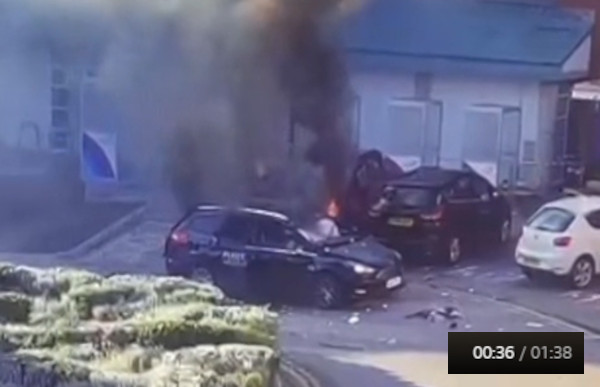
Spencer can be discerned by his mask, showing quite brightly here, in between the two black columns of smoke. The perspective makes it look as though he might be level with the back door, but in fact he has moved to the rear beyond that point as well as away towards the building.
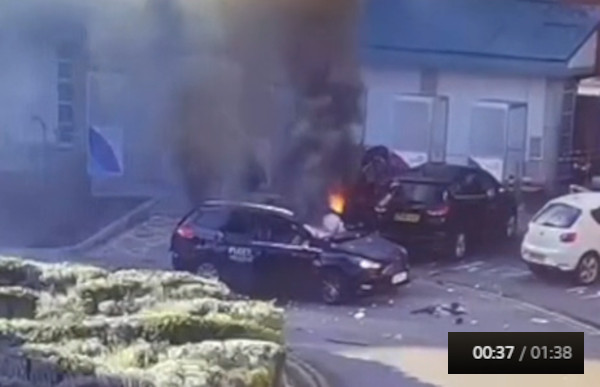
Spencer is seen as a dark figure, with right arm discernible, framed in the white rectangle (belonging to the box of the type seen elsewhere in the shot). His back faces the viewer as he continues to move away from the vehicle.
When Spencer retreats again, moving back towards the rear of the vehicle, this is when the flame in the front of the car accelerates. The black smoke makes it difficult to see what Spencer is doing, but in a few frames he looks as if his steps are taking him away from the car. This is confirmed when, a few seconds later, his girlfriend comes out to collect him (one might presume), and the way that her body is pointing as she moves towards him indicates that Spencer is somewhat removed from the car.
In his account, however, it is roughly at this point when he approaches the car to see if he can pull Al Swealmeen out:
“I never saw the driver get out so I ran to the driver’s side of the car to see if he was still in there, or if anyone else was still in there.
“Then I saw the driver [outside the vehicle] who was in quite an awful state standing with the security guard in the ambulance bay.
“I went back to the car because I was asking if anyone else in the car, but I don’t think they quite understood what I was saying because everyone was in shock.
“I ran back to check and that’s when I saw the man in the car.
“He was on fire.”
Liam said he was unable to comment if the passenger and now terror suspect, Emad Al Swealmeen, was still alive at this point.
Liam said: “I just seen him and the top half of his body through the rear door.
“I think the door had been blown off, I can’t really recall. But I remember it being slightly open.
“I didn’t want to injure myself but I was looking at the best way to get him out of the car.
“I initially went close to see if I could grab him because the flames weren’t as big at that point.
“As I got close the flames engulfed him and that’s when I ran to go and get a fire extinguisher and then the security came out with one.”
The reader will be sure to notice that, once again, there is no indication that anyone else in the vicinity, including the driver, is able to answer an inquiry about the taxi containing a passenger. Note also, Spencer declares that he looked while he was on the driver’s side to see if “anyone” was in the car. Given that the driver’s door was open, and if Spencer had seen Al Swealmeen, this is where we might have seen him poke his head into the vehicle at least to ascertain if Al Swealmeen could be rescued. He doesn’t react as if he has seen another person in the car – not in this instance, and indeed, according to the author’s view, not at any point when he is circling the vehicle.
On the morning of November 15th – so the day after the incident – the Daily Mail published the fully formed official narrative, with every detail including what passed between Al Swealmeen and Perry (via his “friends”), and within this grand assertion the following was stated:
One witness can be seen looking into the back seat passenger. He decides the passenger is dead and can’t be saved.
Now, the imaginative reader can perhaps see the problem that the script writer here has stored up from himself, what with Spencer being an Asda delivery driver, and not one qualified to tell at a glance whether a man be dead or alive. And while this scripting is clearly an attempt to explain while no one in the footage reacted as they believed a man was trapped in a burning car, it is far from adequate. That no one even tried to pull Al Swealmeen from his doom is a narrative stumbling block. This is why, the author posits, Spencer was got at in order to have him incorporate a saving stroke into his account. But the detail of Spencer trying to stage a rescue also has the effect of infringing on narrative parameters already wholly established – and this smacks of what we might call script writer fidget.
The problem in question is the bit in Spencer’s account about how he finds the passenger side rear door open. Of course, this is contrary to one of the very first narrative talking points where David Perry locked the car doors so that Al Swealmeen could not exit. Indeed, the official narrative depends on the feature of the story as a fact because it forces an assumption that Al Swealmeen set off the bomb because he was trapped (and so it is very interesting to see the narrative change – as it now has – to tolerate the possibility of an accidental “explosion”).
The author suggests that the door is now open because it is narrative device which allows the consumer of the tale to accept the idea of an attempted rescue. And because this is an incredibly significant piece of new information, it is couched in uncertainty in order to underplay it: Spencer cannot remember how the door happens to be open. It is a fudge of the sort an event sceptic is not unused to seeing. Furthermore, and crucially, it is a big indicator of script work, because a normal person wouldn’t bother giving a back story for the door: it’s not a natural witness’ concern how he comes to find a situation.
Ultimately, the open door is at the crux of understanding what is going on in this incident. That someone opened the door is an idea off limits, because it stands for the suspect being incapable one way or another. So, if you don’t believe that there had been an explosion strong enough to blow a car door off of its mounting into which it had been locked – and it doesn’t look like it could have been – then this aspect of Spencer’s story, introduced to give the impression that rescue might have been possible, is a lie. It then follows that one doesn’t have to believe Spencer when he claims to have seen Al Swealmeen. In fact, this is especially true when one is asked to accept that Al Swealmeen went up like kindling, and this was the factor that stopped Spencer dragging him from the car. It looks like a fairy tale to cover the simplest explanation for no rescue: Al Swealmeen was not in the car.
Finally, it’s not realistic to know about character from people’s features, but when one has a close look at Liam Spencer and his girlfriend Stephanie Stitt, one can imagine the reaction they would have had when the real world came crashing into their “X-Factor reality” in the shape of the UK’s security apparatus telling them what happened and what didn’t happen, despite what they might otherwise like to think (“I haven’t stopped crying because… I’m just thinking that things could have been different, like my life could have been lost more than anything or I could be in a worse situation than I am now” Miss Stitt told the BBC). We might suspect David Perry has been briefed likewise (in fact, it has been reported, albeit framed in a different way: “yesterday a male and female officer arrived at his neat terraced home in the north of the city… to gently quiz him about what happened in the moments before the device was activated”). However, as Perry, the only other person who could testify to another person being in his cab, has not yet appeared in person in corporate-media, perhaps this is because he is not as capable of being so readily convinced as Spencer. Who really knows?
Update, 21st November: This afternoon, a day after the publication of this article, corporate-media carries news that police have released a statement by David Perry. Having found a copy at Sky News of what appears to be the entire message, it is reproduced here:
“On behalf of myself, Rachel and our family, we would like to say thank you to everyone for all your get well wishes and for your amazing generosity. We are completely overwhelmed with it.
“I feel like it’s a miracle that I’m alive and so thankful that no one else was injured in such an evil act. I now need time to try to come to terms with what’s happened and focus on my recovery both mentally and physically.
“Please be kind, be vigilant and stay safe.”
The author (repeatedly) makes no claim that the UK Government reacts to this site, even though this sort of thing does happen a lot. Obviously, in a coincidence, someone handling the David Perry public relations case also must have realised that it had been an abnormally long time (especially in the day and age of celebrity terror victim) without him featuring in person (one way or another) in corporate-media.




